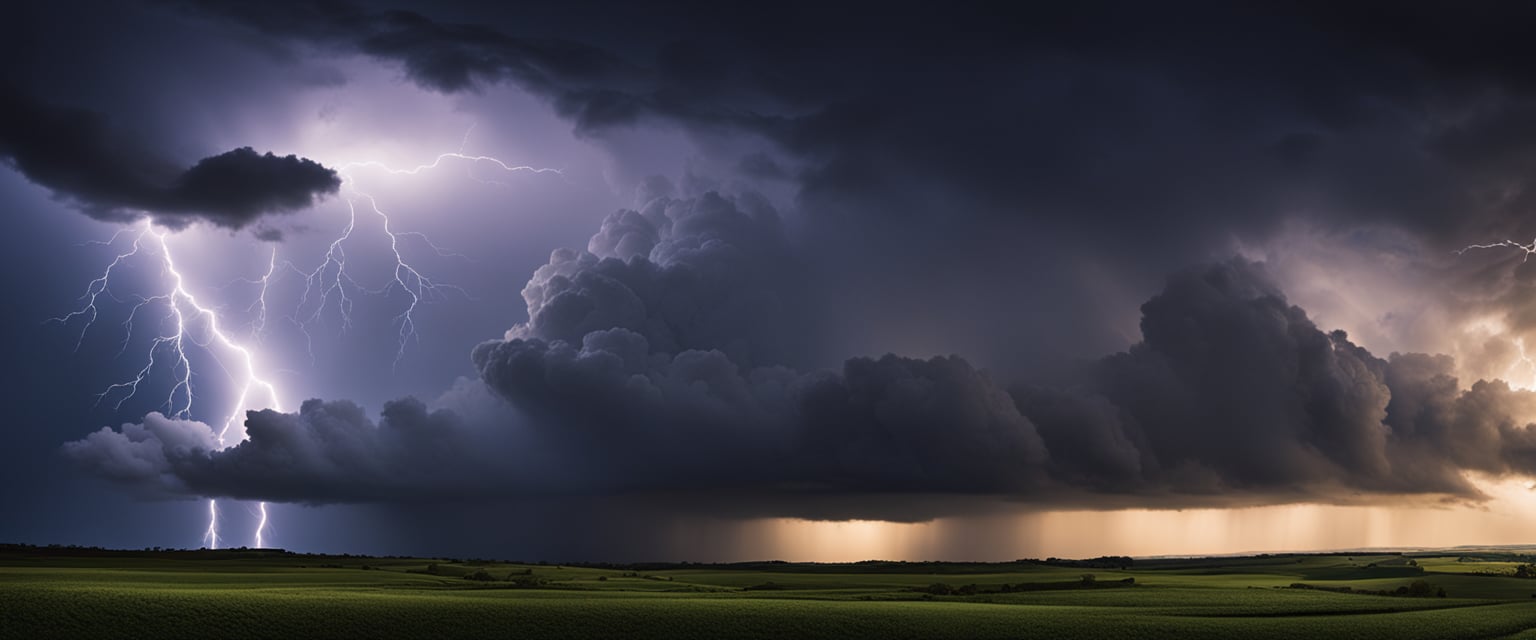
Predicting weather in the wild is a complex and challenging task that requires a deep understanding of meteorology, weather prediction techniques, and a range of other factors. Whether you are planning a camping trip, a hiking adventure, or any other outdoor activity, it’s essential to have a good understanding of the weather conditions you can expect. This article will explore the science behind predicting weather in the wild, providing you with the knowledge and insights you need to stay safe and make informed decisions.
To begin, it’s important to understand the fundamentals of meteorology, which is the study of the Earth’s atmosphere and how it interacts with the planet’s surface. Meteorologists use a range of tools and techniques to monitor and analyze weather patterns, including satellites, weather balloons, and ground-based sensors. By collecting and analyzing data from these sources, meteorologists can develop a detailed understanding of weather patterns and make accurate predictions about future conditions.
However, predicting weather in the wild can be more challenging than forecasting conditions in urban or suburban areas. This is because wilderness areas often lack the infrastructure and resources needed to collect and analyze weather data. In addition, weather conditions in the wild can be more extreme and unpredictable, making it difficult to develop accurate predictions. Despite these challenges, there are a range of techniques and strategies that can be used to predict weather in the wild, which we will explore in more detail in this article.
Key Takeaways
- Predicting weather in the wild requires a deep understanding of meteorology and weather prediction techniques.
- Wilderness areas can be more challenging to forecast than urban or suburban areas due to a lack of resources and extreme weather conditions.
- There are a range of techniques and strategies that can be used to predict weather in the wild, which can help outdoor enthusiasts stay safe and make informed decisions.
Fundamentals of Meteorology

Atmospheric Dynamics
The study of atmospheric dynamics is essential to understanding how weather patterns form and change. Atmospheric dynamics involves the study of how air moves and how it interacts with other elements in the atmosphere. Wind, for example, is a result of differences in air pressure between different regions of the atmosphere. Meteorologists use a variety of tools to measure and predict wind patterns, including anemometers, wind vanes, and Doppler radar.
Temperature and Pressure Systems
Temperature and pressure systems play a crucial role in the formation of weather patterns. Warm air rises and cool air sinks, creating areas of high and low pressure. Meteorologists use instruments like barometers to measure air pressure and thermometers to measure temperature. By tracking changes in temperature and pressure over time, meteorologists can predict how weather patterns will evolve.
Moisture and Precipitation Cycles
Moisture in the atmosphere is another critical factor in weather prediction. As air rises, it cools, and the moisture in the air condenses into clouds. If the conditions are right, the moisture in the clouds will fall to the ground as precipitation. Meteorologists use tools like rain gauges and weather balloons to measure moisture levels in the atmosphere.
In conclusion, understanding the fundamentals of meteorology is essential for predicting weather patterns accurately. By studying atmospheric dynamics, temperature and pressure systems, and moisture and precipitation cycles, meteorologists can make more informed predictions about the weather in the wild.
Weather Prediction Techniques
When it comes to predicting weather in the wild, there are several techniques that meteorologists use to collect data, build forecasting models, and utilize remote sensing and satellites. Here are some of the most common methods:
Data Collection Methods
The first step in predicting weather is collecting data. This can be done through a variety of methods, including:
- Weather stations: These are ground-based instruments that measure temperature, humidity, air pressure, wind speed, and precipitation.
- Radiosondes: These are weather balloons that carry instruments to measure temperature, humidity, air pressure, and wind speed as they ascend through the atmosphere.
- Aircraft: Planes can collect data on temperature, humidity, air pressure, and wind speed at various altitudes.
- Satellites: These can provide information on cloud cover, temperature, and other weather-related factors from space.
Forecasting Models
Once data is collected, it is used to build forecasting models. These models use mathematical equations to predict future weather patterns. Some of the most common forecasting models include:
- Numerical Weather Prediction (NWP): This model uses complex mathematical equations to predict weather patterns based on current data.
- Ensemble Forecasting: This model uses multiple forecasting models to generate a range of possible weather scenarios.
- Statistical Forecasting: This model uses historical weather data to predict future weather patterns.
Remote Sensing and Satellites
Remote sensing and satellites are used to gather data from areas that are difficult to access. They can provide information on cloud cover, temperature, and other weather-related factors from space. Some of the most common remote sensing and satellite technologies include:
- Radar: This technology uses radio waves to detect precipitation and measure its intensity.
- Lidar: This technology uses lasers to measure cloud cover and other atmospheric conditions.
- Infrared Imaging: This technology uses infrared radiation to detect temperature differences in the atmosphere.
By utilizing these weather prediction techniques, meteorologists can provide accurate and timely weather forecasts to help keep you safe in the wild.
Challenges in Wilderness Weather Forecasting
Terrain and Topography Influence
When predicting weather in the wilderness, one of the biggest challenges is the influence of terrain and topography. Mountains, valleys, and other land formations can greatly affect weather patterns, making it difficult to accurately predict weather in specific areas. For example, a storm may pass over a mountain range and cause heavy rain on one side, while leaving the other side relatively dry.
To overcome this challenge, weather forecasters must take into account the unique topography of the area they are predicting weather for. This can be done by using computer models that simulate how air moves over different types of terrain. Additionally, forecasters may rely on data from weather stations located in the area, as well as satellite imagery, to get a more accurate picture of the conditions.
Limited Data Availability
Another challenge in wilderness weather forecasting is the limited availability of data. In many remote areas, there may be few or no weather stations, making it difficult to gather the data needed to make accurate predictions. Additionally, weather conditions can change rapidly in the wilderness, making it difficult to keep up with the latest information.
To address this challenge, weather forecasters may rely on data from nearby weather stations, as well as satellite imagery and other remote sensing technologies. Additionally, they may use computer models to simulate weather patterns based on the limited data available. However, it is important to note that these methods may not always provide the most accurate predictions, and forecasters must use their expertise and experience to make the best possible predictions given the available data.
Impact of Climate Change on Predictive Accuracy

Long-Term Trends and Variability
Climate change has been an ongoing concern for the scientific community, as it poses a significant threat to the accuracy of weather forecasting. The increase in global temperatures, for example, can lead to changes in the patterns of atmospheric circulation, which can then affect the predictability of weather conditions.
Long-term trends and variability in climate can also make it difficult to accurately predict weather conditions. Climate models are designed to simulate the complex interactions between the atmosphere, oceans, and land surface, but the accuracy of these models can be affected by the quality and quantity of data available.
Extreme Weather Events
Extreme weather events, such as hurricanes, tornadoes, and heatwaves, are becoming more frequent and intense due to climate change. These events can be particularly challenging to predict accurately, as they are often influenced by a combination of factors, including regional weather patterns, ocean temperatures, and atmospheric conditions.
The accuracy of predictive models for extreme weather events is crucial for effective disaster management and emergency response. However, the complexity of these events and the limited availability of data can make accurate predictions difficult.
In conclusion, climate change poses a significant challenge to the accuracy of weather forecasting, particularly for long-term trends and extreme weather events. While predictive models continue to improve, ongoing research and data collection are necessary to ensure that weather forecasting remains reliable and effective.
Practical Tips for Outdoor Enthusiasts

Understanding Weather Reports
Being able to understand weather reports is essential for anyone planning to spend time in the wilderness. Make sure to check the forecast before heading out and pay attention to any warnings or alerts issued by the National Weather Service.
When reading a weather report, pay attention to the following:
- Temperature: This is an important factor to consider when planning what to wear and what gear to bring.
- Wind: Wind can make temperatures feel colder or hotter than they actually are and can also affect your safety when hiking or camping.
- Precipitation: Knowing if it’s going to rain or snow can help you plan your activities and gear accordingly.
- Barometric Pressure: Changes in barometric pressure can indicate changes in weather patterns, so it’s important to keep an eye on this.
Preparation and Safety Measures
Preparing for the worst-case scenario is crucial when spending time in the wilderness. Here are some practical tips to help you stay safe:
- Bring appropriate clothing: Layering is key to staying comfortable and safe in changing weather conditions. Make sure to bring clothing that is waterproof, windproof, and breathable.
- Pack essential gear: Always bring a map, compass, and GPS device to help you navigate. Other essential items include a first-aid kit, water filtration system, and extra food and water.
- Know your limits: Be honest with yourself about your physical abilities and experience level. Don’t attempt a difficult hike or climb if you’re not prepared or experienced enough.
- Be aware of your surroundings: Keep an eye on the weather and any changes in conditions. Look out for signs of hypothermia or other weather-related illnesses.
By following these practical tips and staying informed about weather conditions, you can enjoy your time in the wilderness while staying safe and prepared for any situation.
Frequently Asked Questions

How can animal behavior be used to forecast weather conditions?
Animal behavior can be a useful indicator of upcoming weather changes. For example, birds may fly lower to the ground before a storm, and cows may lie down before a heavy rain. Observing animal behavior can give insight into the atmospheric pressure and temperature changes that often precede a weather event.
What are traditional methods for predicting weather patterns?
Traditional methods for predicting weather patterns include observing cloud formations, wind direction, and changes in humidity. Many indigenous communities have developed their own methods for predicting weather based on natural signs, such as the appearance of certain plants or the behavior of animals.
In what ways do indigenous communities utilize natural knowledge for weather prediction?
Indigenous communities often have a deep understanding of the natural world and have developed their own methods for predicting weather based on this knowledge. For example, some communities in Africa use the behavior of termites to predict rainfall, while some tribes in North America observe the patterns of migratory birds to forecast weather changes.
What techniques involve celestial observations for weather forecasting?
Celestial observations can be used to predict weather changes. For example, observing the position of the moon in the sky can give insight into atmospheric pressure, while observing the position of the stars can give clues about wind direction and speed.
How can one predict weather changes without the use of modern technology?
There are many ways to predict weather changes without the use of modern technology. Observing natural signs such as cloud formations, animal behavior, and changes in humidity can give insight into upcoming weather events. Traditional knowledge passed down through generations can also be a valuable resource for predicting weather.
What are the principles underlying the science of meteorology?
Meteorology is the study of the Earth’s atmosphere and the processes that govern its behavior. It is based on the principles of physics, chemistry, and mathematics, and involves the use of sophisticated computer models and observational tools to predict weather patterns.

Leave a Reply